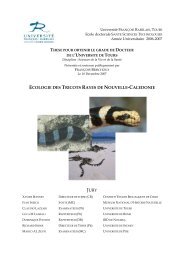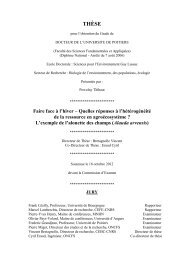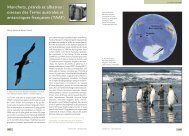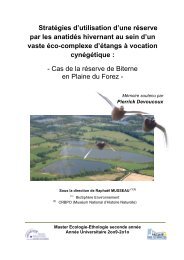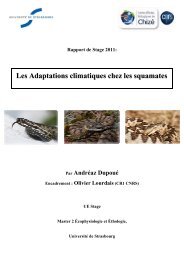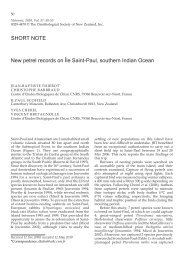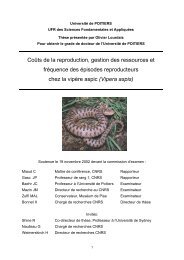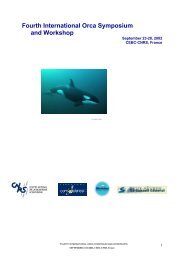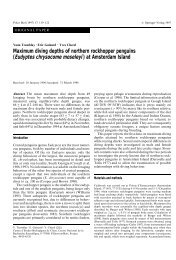Forçage environnemental et prédateurs marins ... - Cebc - CNRS
Forçage environnemental et prédateurs marins ... - Cebc - CNRS
Forçage environnemental et prédateurs marins ... - Cebc - CNRS
You also want an ePaper? Increase the reach of your titles
YUMPU automatically turns print PDFs into web optimized ePapers that Google loves.
oth) 16 . Decreased frequency of krill recruitment associated with a<br />
decreased frequency of extensive winter sea-ice may be responsible<br />
for low population sizes of krill 17 , and lower krill abundance is<br />
associated with areas with less winter sea-ice cover 5 . In years with<br />
high SSTs, emperor penguins probably have dif®culties in ®nding<br />
food, which could increase mortality. It is not known when the<br />
survival of adult emperor penguins is affected by warm water events:<br />
wh<strong>et</strong>her during winter when males and females undertake long<br />
incubation and chick brooding fasts 18,19 , or during the summer<br />
when they disperse to moult 20 .<br />
Breeding success varied extensively throughout the period, and<br />
its variability has increased progressively since the 1970s (Fig. 1c).<br />
A combination of local factors has probably contributed to the high<br />
variability in breeding success. Compl<strong>et</strong>e or extensive breeding<br />
failures in some years resulted from early break-out of the sea-ice<br />
holding up the colony, or from prolonged blizzards during the early<br />
chick-rearing period 21 . Overall breeding success was not related to<br />
SST anomalies or sea-ice extent, possibly because variation was the<br />
result of a combination of confounding factors related to sea-ice<br />
conditions or weather conditions. However, the proportion of eggs<br />
that hatched a chick was negatively related to the extent of pack ice<br />
in winter (r 2 = 0.284, P = 0.02), with wider pack ice resulting in<br />
lower hatching success.<br />
One paradoxical and unexpected result of this study is that the<br />
extent of pack ice, which is a key factor in the Antarctic ecosystem 7 ,<br />
has two opposite effects on the demographic param<strong>et</strong>ers of emperor<br />
penguins. Sea-ice extent in winter negatively affects hatching<br />
success, by increasing the distance b<strong>et</strong>ween the colony and feeding<br />
grounds. Conversely, annual sea-ice extent positively affects adult<br />
survival by increasing food availability. Therefore there exists in<br />
emperor penguins a trade-off b<strong>et</strong>ween the advantages and disadvantages<br />
of extensive pack ice. In population terms, the trophic<br />
advantage of extensive pack ice, by favouring higher survival and<br />
further reproduction, outmatches its physical disadvantage of<br />
reducing fecundity.<br />
Whereas time series on emperor penguins and on m<strong>et</strong>eorological<br />
conditions in the colony are available since 1952, data on the extent<br />
of sea-ice are available only from 1972 onwards, and on SST from<br />
1982. Given the strong relationship b<strong>et</strong>ween survival and SST<br />
anomalies related to the Antarctic Circumpolar Wave 2 in 1982±<br />
1989, low survival during 1976±1980 (and the 50% population<br />
decrease) was probably associated with high SSTs, but remotesensing<br />
satellite data were not available at this time. The temperature<br />
recorded in winter in the colony, however, indicates a prolonged<br />
warm period during the 1970s (Fig. 1a) associated with a prolonged<br />
period of decreasing extent of ice 1 (Fig. 1d). This anomaly is<br />
probably connected to the abrupt decline in Antarctic sea-ice<br />
extent that is apparent from whaling records during the 1960s<br />
and 1970s 1,3 . The exact timing of the decline is not known because of<br />
the lack of records during this period 3 . Our results indicate that this<br />
major event may have occurred during the 1970s rather than during<br />
the 1960s as suggested earlier. Our results also indicate that emperor<br />
penguins may be very susceptible to environmental variability and<br />
that further long-lasting coupled anomalies are likely to affect their<br />
populations. M<br />
M<strong>et</strong>hods<br />
We d<strong>et</strong>ermined the number of breeding pairs from the number of chicks ¯edged plus the<br />
number of eggs and chicks found dead. Dead chicks and eggs remain frozen on sea-ice<br />
around the colony and were collected and counted daily during the entire breeding season.<br />
The number of breeding pairs represents 80% of the overall population size.<br />
Environmental param<strong>et</strong>ers<br />
We used three types of data: the annual average SST calculated from a combination of<br />
in situ and satellite-radiom<strong>et</strong>er measurements obtained on a 18 grid22 ; the annual average<br />
northward sea-ice extent calculated from space-borne microwave sensors on a 25-km<br />
grid 23 ; and the annual averages of atmospheric sea-level pressure calculated from data<br />
produced by the European Centre for Medium Range Weather Forecasts on a 1.8758 grid24 ,<br />
all spanning 1982±1989. Data were extracted for the 200-km radius (from latitude 66.78 S)<br />
l<strong>et</strong>ters to nature<br />
surrounding the Pointe GeÂologie colony, an area consistent with the foraging radius of<br />
emperor penguins 11,19 . Physical param<strong>et</strong>ers were d<strong>et</strong>ermined relative to the applicable<br />
record length annual mean values and ®ltered to suppress seasonal and possible biennial<br />
signals 2 .<br />
Survival modelling<br />
Adults were ringed each year b<strong>et</strong>ween 1967 and 1980 using m<strong>et</strong>al bands placed at the base<br />
of the ¯ippers. Ringing and ring readings were made in April and May when birds arrived<br />
on the breeding grounds forming columns and during pair formation from 1968 until<br />
today9 . Because during the ®rst year after banding, and to a lesser extent during the second<br />
year, bands are more likely to be lost or to affect survival 25 , we have excluded data from the<br />
®rst two years after banding. We estimated adult survival rate using recent developments<br />
of the Cormack±Jolly±Seber model26,27 implemented in the MARK software28 for the<br />
period 1969±1988. This m<strong>et</strong>hod allows the estimation of unbiased capture and survival<br />
probabilities. Param<strong>et</strong>ers that may explain time-variation in survival were then examined<br />
using the capture±mark±recapture data s<strong>et</strong> over the period 1982±1989, when data were<br />
simultaneously available with adult survival (before 1982, no physical data were available).<br />
The 1982±1989 data s<strong>et</strong> was used to test the effects of physical param<strong>et</strong>ers on survival.<br />
D<strong>et</strong>ails of survival modelling procedures are available as Supplementary Information.<br />
Changes in breeding population size from year to year should be correlated with<br />
survival if variations in the latter are a principal cause of the former. To test wh<strong>et</strong>her the<br />
temporal variation in survival is likely to have been a signi®cant cause of changes in<br />
population size we used a covariate model in which the interannual per cent change in the<br />
breeding population size was added to the selected model as an annual covariate29 with a<br />
one-year lag, as the breeding population size of emperors was d<strong>et</strong>ermined in May.<br />
Received 23 October 2000; accepted 20 February 2001.<br />
1. Kukla, G. & Gavin, J. Summer ice and carbon dioxide. Science 214, 497±503 (1981).<br />
2. White, W. B. & P<strong>et</strong>erson, R. G. An Antarctic circumpolar wave in surface pressure, wind, temperature<br />
and sea-ice extent. Nature 380, 699±702 (1996).<br />
3. de la Mare, W. K. Abrupt mid-twenti<strong>et</strong>h century decline in Antarctic sea-ice extent from whaling<br />
records. Nature 389, 57±60 (1997).<br />
4. Tynan, C. T. Ecological importance of the Southern Boundary of the Antarctic Circumpolar current.<br />
Nature 392, 708±716 (1998).<br />
5. Nicol, S. <strong>et</strong> al. Ocean circulation off east Antarctica affects ecosystem structure and sea-ice extent.<br />
Nature 406, 504±507 (2000).<br />
6. Aebischer, N. J., Coulson, J. C. & Colebrook, J. M. Parallel long-term trends across four marine trophic<br />
levels and weather. Nature 347, 753±755 (1990).<br />
7. Croxall, J. P. Southern Ocean environmental changes: effects on seabird, seal and whale populations.<br />
Phil. Trans. R. Soc. Lond. B 338, 319±328 (1992).<br />
8. Furness, R. W. & Greenwood, J. J. D. (eds) Birds as Monitors of Environmental Change (Chapman and<br />
Hall, London, 1993).<br />
9. PreÂvost, J. Ecologie du Manchot Empereur Aptenodytes forsteri Grey (ExpeÂditions Polaires FrancËaises,<br />
Hermann, Paris, 1961).<br />
10. LeMaho, Y. The Emperor penguin: a strategy to live and breed in the cold. Am. Sci. 65, 680±693<br />
(1977).<br />
11. Kirkwood, R. & Robertson, G. The foraging ecology of female Emperor Penguins in winter. Ecol.<br />
Monogr. 67, 155±176 (1997).<br />
12. Lebr<strong>et</strong>on, J. D. & Clobert, J. in Bird Population Studies (eds Perrins, C. M., Lebr<strong>et</strong>on, J. D. & Hirons,<br />
G. J. M.) 103±125 (Oxford Univ. Press, Oxford, 1991).<br />
13. Williams, T. D. The Penguins (Oxford Univ. Press, Oxford, 1995).<br />
14. Offredo, C. & Ridoux, V. The di<strong>et</strong> of Emperor penguins Aptenodytes forsteri in AdeÂlie land, Antarctica.<br />
Ibis 128, 409±413 (1986).<br />
15. Cherel, Y. & Kooyman, G. L. Food of emperor penguins (Aptenodytes forsteri) in the western Ross Sea,<br />
Antarctica. Mar. Biol. 130, 335±344 (1998).<br />
16. Pakhomov, E. A. & McQuaid, C. D. Distribution of surface zooplankton and seabirds across the<br />
Southern Ocean. Polar Biol. 16, 271±286 (1996).<br />
17. Loeb, V. <strong>et</strong> al. Effects of sea-ice extent and krill or salp dominance on the Antarctic food web. Nature<br />
387, 897±900 (1997).<br />
18. Isenmann, P. Contribution aÁ l'eÂthologie <strong>et</strong> aÁ l'eÂcologie du Manchot empereur (Aptenodytes forsteri<br />
Gray) aÁ la colonie de Pointe GeÂologie (Terre AdeÂlie). Oiseau R.F.O. 41, 9±61 (1971).<br />
19. Ancel, A. <strong>et</strong> al. Foraging behaviour of emperor penguins as a resource d<strong>et</strong>ector in winter and summer.<br />
Nature 360, 336±338 (1992).<br />
20. Kooyman, G., Hunke, E., Ackley, S., van Dam, R. & Robertson, G. Moult of the emperor penguin:<br />
travel, location, and habitat selection. Mar. Ecol. Prog. Ser. 204, 269±277 (2000).<br />
21. Jouventin, P. in The Biology of Penguins (ed. Stonehouse, B.) 435±446 (Macmillan, London, 1974).<br />
22. Reynolds, R. W. & Marisco, D. C. An improved real time global sea surface temperature analysis.<br />
J. Climate 6, 114±119 (1993).<br />
23. Parkinson, C. L. Spatial patterns in the length of the sea ice season in the Southern Ocean, 1979-1986.<br />
J. Geophys. Res. 99, 16327±16339 (1994).<br />
24. ECMWF/WCRP. A Global Atmospheric Data Archive (Tech. Attach. European Centre for Medium<br />
Range Weather Forecasts, Reading, 1993).<br />
25. Weimerskirch, H., Stahl, J. C. & Jouventin, P. The breeding biology and population dynamics of king<br />
penguins Aptenodytes patagonicus at the Croz<strong>et</strong> islands. Ibis 134, 107±117 (1992).<br />
26. Nichols, J. D. Capture±recapture models: using marked animals to study population dynamics.<br />
Bioscience 42, 94±102 (1991).<br />
27. Lebr<strong>et</strong>on, J. D., Burnham, K. P., Clobert, J. & Anderson, D. R. Modeling survival and testing biological<br />
hypotheses using marked animals: a uni®ed approach with case studies. Ecol. Monogr. 62, 67±118<br />
(1992).<br />
28. White, G. C. & Burnham, K. P. Program MARK: survival estimation from populations of marked<br />
animals. Bird Study 46, 120±138 (1999).<br />
29. Siriwardena, G. M., Baillie, S. R. & Wilson, J. D. Temporal variation in the annual survival rates of six<br />
granivorous birds with contrasting population trends. Ibis 141, 621±636 (1999).<br />
NATURE | VOL 411 | 10 MAY 2001 | www.nature.com © 2001 Macmillan Magazines Ltd<br />
185



